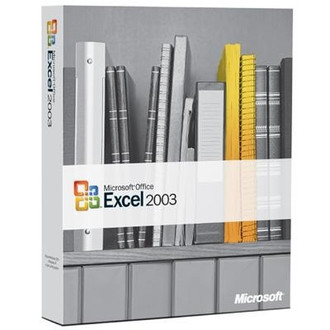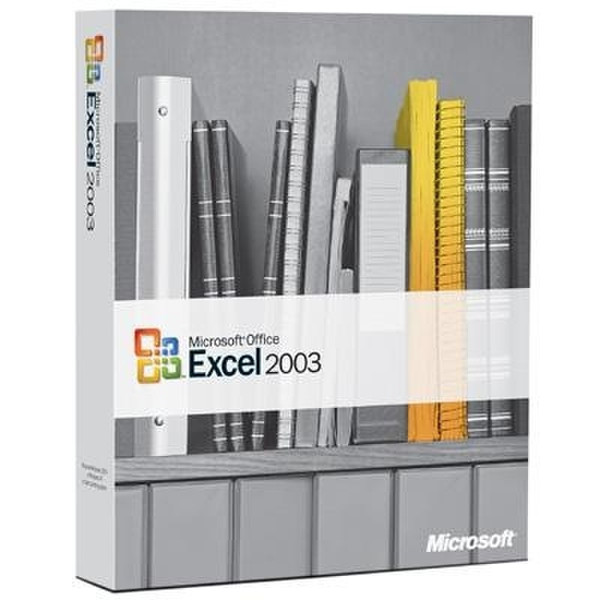Catalog
-
Catalog
- Antiquitäten & Kunst
- Auto & Motorrad: Fahrzeuge
- Baby
- Business & Industry
- Bücher
- Camping & Outdoor
- Feinschmecker
- Garten & Terrasse
- Haushalt & Wohnen
- Haustierbedarf
- Heimwerken & Garten
- HiFi & Audio
- Home, Construction, Renovation
- Household appliances
- Kleidung & Accessoires
- Modellbau
- Musik
- PC- & Videospiele
- Photo & camcorders
- Sammeln & Seltenes
- Spielzeug
- TV, Video, DVD
- Telekommunikation
- Uhren & Schmuck
- Wellness & Beauty
- computers & electronics
- entertainment & hobby
- fashion & lifestyle
- food, beverages & tobacco
- garden & patio
- health & beauty
- institutional food services equipment
- medical equipment, accessories & supplies
- office
- sports & recreation
- vehicles & accessories
- weapons & ammunition
Filters
Search

Microsoft Excel 2003, Win32, DocKit, JPN
MPN: 065-04384
🚚 Select the country of delivery:
Delivery from:
Germany
Sale and delivery by:
Where to buy and prices (Advertising *)
On Top
Technical specifications
On Top
Technical details
| Mac compatibility | N |
|---|
Excel 2003, Win32, DocKit, JPN
Excel 2003 enables you to turn data into information with powerful tools to analyze, communicate, and share results. Excel 2003 can help you work better in teams, and help protect and control access to your work. In addition, you can work with industry-standard Extensible Markup Language (XML) data to make it easier to connect to business processes.
<b>Capture and Reuse Data</b>
Bring key business data into your spreadsheets for more timely access to the information you need to make good decisions.
- Take advantage of data wherever it exists. Excel 2003 can read data in any customer-defined XML schema without reformatting. You can analyze and manipulate XML data sources using charts, tables, or graphs.
- Note In all Office 2003 Editions, Excel 2003 spreadsheets can be saved in a native XML file format which can be manipulated and searched using any program that can process industry standard XML. With Microsoft Office Professional Edition 2003, companies can also use customized XML formats—or schemas—to enable easier and more advanced information creation, capture, exchange, and reuse.
- Develop your own data solutions. Experienced Excel users can use the new visual XML mapping tool to map a user-specified XML schema to fields in an Excel 2003 spreadsheet.
- Analyze data better. Excel 2003 builds on its commitment to reliable and accurate numerical analysis with enhancements in collinearity detection, calculations of sum of squared deviations, normal distributions, and continuous probability distribution functions.
- Customize functionality with enhanced smart tags. Smart tags in Excel 2003 are more flexible. Associate smart tag actions with a specific section of a spreadsheet and have the smart tag appear only when you hover the mouse over the associated range of cells.
- Interact with business systems. Developers can build document-based solutions that take advantage of the XML support in Excel 2003. For example, they can program task panes to display relevant tasks and information to help automate business processes.
<b>Share Information with Confidence</b>
Work together effectively—internally and with other organizations—and help protect against the misuse of sensitive company information.
- Work together better. Save Excel 2003 spreadsheets to shared workspaces where other team members can get the latest version and save task lists, related files, links, and member lists. Shared workspaces require Microsoft Windows Server™ 2003 running Microsoft Windows® SharePoint™ Services.
- Edit lists in Windows SharePoint Services. Integration with Windows SharePoint Services allows you to compose lists in Excel 2003 spreadsheets and transfer them to Windows SharePoint Services sites for easier editing. You can edit the lists in Excel 2003 or on the Windows SharePoint Services site.
- Control distribution of your work. Help protect company assets by preventing recipients from forwarding, copying, or printing important spreadsheets using information rights management (IRM) functionality. You can grant others permission to view, review, or modify your spreadsheet, and you can set an expiration date, after which others cannot view or change it. IRM functionality requires Windows Server 2003 running Microsoft Windows Rights Management Services (RMS).
- Note With Office Professional Edition 2003, you can use Excel 2003 to create IRM-protected spreadsheets and grant others permission to access and modify your spreadsheets. You can also apply policy templates to IRM-protected spreadsheets you create. With Microsoft Office Standard Edition 2003, Microsoft Office Small Business Edition 2003, and Microsoft Office Student and Teacher Edition 2003 you can read IRM-protected spreadsheets; with permission, you can modify them as well.
<b>Capture and Reuse Data</b>
Bring key business data into your spreadsheets for more timely access to the information you need to make good decisions.
- Take advantage of data wherever it exists. Excel 2003 can read data in any customer-defined XML schema without reformatting. You can analyze and manipulate XML data sources using charts, tables, or graphs.
- Note In all Office 2003 Editions, Excel 2003 spreadsheets can be saved in a native XML file format which can be manipulated and searched using any program that can process industry standard XML. With Microsoft Office Professional Edition 2003, companies can also use customized XML formats—or schemas—to enable easier and more advanced information creation, capture, exchange, and reuse.
- Develop your own data solutions. Experienced Excel users can use the new visual XML mapping tool to map a user-specified XML schema to fields in an Excel 2003 spreadsheet.
- Analyze data better. Excel 2003 builds on its commitment to reliable and accurate numerical analysis with enhancements in collinearity detection, calculations of sum of squared deviations, normal distributions, and continuous probability distribution functions.
- Customize functionality with enhanced smart tags. Smart tags in Excel 2003 are more flexible. Associate smart tag actions with a specific section of a spreadsheet and have the smart tag appear only when you hover the mouse over the associated range of cells.
- Interact with business systems. Developers can build document-based solutions that take advantage of the XML support in Excel 2003. For example, they can program task panes to display relevant tasks and information to help automate business processes.
<b>Share Information with Confidence</b>
Work together effectively—internally and with other organizations—and help protect against the misuse of sensitive company information.
- Work together better. Save Excel 2003 spreadsheets to shared workspaces where other team members can get the latest version and save task lists, related files, links, and member lists. Shared workspaces require Microsoft Windows Server™ 2003 running Microsoft Windows® SharePoint™ Services.
- Edit lists in Windows SharePoint Services. Integration with Windows SharePoint Services allows you to compose lists in Excel 2003 spreadsheets and transfer them to Windows SharePoint Services sites for easier editing. You can edit the lists in Excel 2003 or on the Windows SharePoint Services site.
- Control distribution of your work. Help protect company assets by preventing recipients from forwarding, copying, or printing important spreadsheets using information rights management (IRM) functionality. You can grant others permission to view, review, or modify your spreadsheet, and you can set an expiration date, after which others cannot view or change it. IRM functionality requires Windows Server 2003 running Microsoft Windows Rights Management Services (RMS).
- Note With Office Professional Edition 2003, you can use Excel 2003 to create IRM-protected spreadsheets and grant others permission to access and modify your spreadsheets. You can also apply policy templates to IRM-protected spreadsheets you create. With Microsoft Office Standard Edition 2003, Microsoft Office Small Business Edition 2003, and Microsoft Office Student and Teacher Edition 2003 you can read IRM-protected spreadsheets; with permission, you can modify them as well.
-
Payment Methods
We accept:










